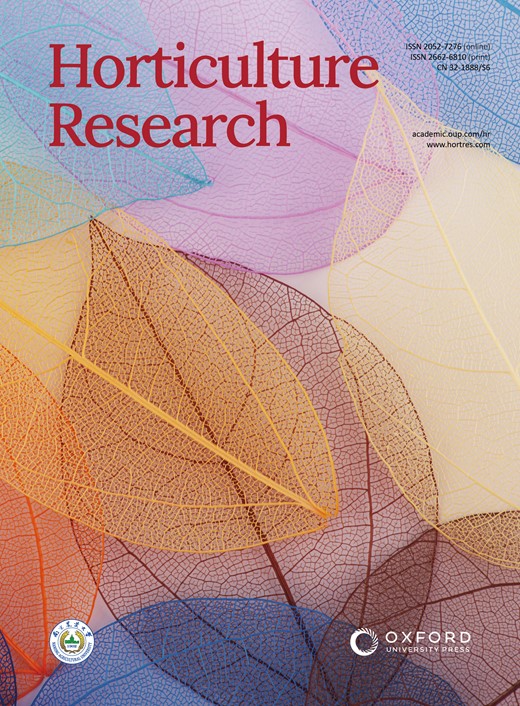微生物群落的昼夜节律及其在调节茶树根圈氮磷循环中的作用
IF 8.7
1区 农林科学
Q1 Agricultural and Biological Sciences
引用次数: 0
摘要
昼夜节律介导植物的新陈代谢功能,并有节奏地塑造根圈微生物群落的结构和功能。然而,目前还不清楚植物宿主的昼夜节律如何调节根圈细菌和真菌群落以及养分循环的变化。在本研究中,我们测量了 20 年茶园根圈细菌和真菌群落以及氮(N)和磷(P)循环的昼夜变化。在变种 LJ43 和 ZC108 的根圈中,真菌群落对昼夜节律变化的反应比细菌群落更稳定。然而,具有昼夜节律的真菌属在午夜时数量更多,丰度更高。在昼夜变化的情况下,LJ43根圈中有机碳和氮的矿化作用更强,而在ZC108中无机氮和磷的循环更容易受到昼夜节律的影响。无论茶叶品种如何,AOA 和 AOB 基因编码的根瘤层脱氮作用在上午都很强。与根瘤固氮(nifH)和反硝化(nosZ和nirK)相关的基因在ZC108中表达水平较高,并在午夜达到峰值。此外,ZC108 根圈微生物群落的昼夜节律在很大程度上调节着氮磷循环的表盘变化。这些结果表明,根瘤菌圈中的细菌和真菌群落对昼夜节律的反应不同,而且在不同茶叶品种之间也存在差异。细菌和真菌循环的时间在很大程度上调节着根瘤菌圈的氮磷循环及其生态功能。本文章由计算机程序翻译,如有差异,请以英文原文为准。
Circadian rhythms of microbial communities and their role in regulating nitrogen and phosphorus cycling in the rhizosphere of tea plants
The circadian clock mediates metabolic functions of plants and rhythmically shapes structure and function of microbial communities in the rhizosphere. However, it is unclear how the circadian rhythm of plant hosts regulates changes in rhizosphere bacterial and fungal communities and nutrient cycles. In the present study, we measured diel changes in the rhizosphere of bacterial and fungal communities, and in nitrogen (N) and phosphorus (P) cycling in 20-year-old tea plantations. The fungal communities were more stable in their responses to circadian changes than bacterial communities in the rhizosphere of the variants LJ43 and ZC108. Nevertheless, fungal genera with circadian rhythms were more numerous and had a higher abundance at midnight. Organic P and N mineralization in the rhizosphere was more intensive in LJ43 under day-night alterations, while inorganic N and P cycling were more easily affected by circadian rhythms in ZC108. The rhizosphere denitrification encoded by the genes AOA and AOB was intensive in the morning, irrespective of tea species. Genes related to rhizosphere N fixation (nifH) and denitrification (nosZ and nirK) expressed at greater levels in ZC108, and they reached a peak at midnight. Moreover, the diel rhythm of rhizosphere microbial communities in ZC108 largely regulated dial changes in N and P cycling. These results suggested that the bacterial and fungal communities in the rhizosphere respond differently to circadian rhythms, and they vary between tea species. The timing of bacterial and fungal cycling largely regulates rhizosphere N and P cycling and their ecological functions.
求助全文
通过发布文献求助,成功后即可免费获取论文全文。
去求助
来源期刊

Horticulture Research
Biochemistry, Genetics and Molecular Biology-Biochemistry
CiteScore
11.20
自引率
6.90%
发文量
367
审稿时长
20 weeks
期刊介绍:
Horticulture Research, an open access journal affiliated with Nanjing Agricultural University, has achieved the prestigious ranking of number one in the Horticulture category of the Journal Citation Reports ™ from Clarivate, 2022. As a leading publication in the field, the journal is dedicated to disseminating original research articles, comprehensive reviews, insightful perspectives, thought-provoking comments, and valuable correspondence articles and letters to the editor. Its scope encompasses all vital aspects of horticultural plants and disciplines, such as biotechnology, breeding, cellular and molecular biology, evolution, genetics, inter-species interactions, physiology, and the origination and domestication of crops.
 求助内容:
求助内容: 应助结果提醒方式:
应助结果提醒方式:


